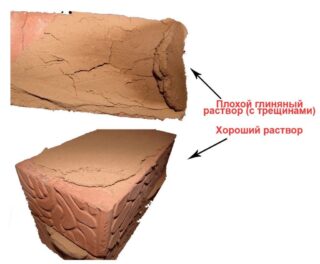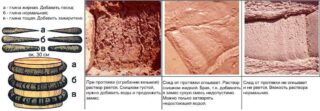For any brick structure, the parameters of the building stone and masonry mortar are important. The latter holds the bricks together so that they form a solid surface. In this case, the joints between the stones, filled with dried mortar, should not act as a "weak link".
- What parameters are affected by the mixture for laying bricks
- Why are problems with the mixture?
- The composition of the clay mortar for masonry ovens
- How to knead correctly
- Clay fat level
- Selection and preparation of sand
- Preparation of clay-sand mortar
- Quality checking
- Accessories for work
- Correcting cooking errors
- How long does it take to dry the oven
What parameters are affected by the mixture for laying bricks
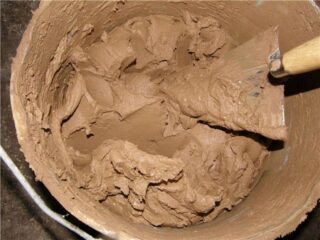
The compositions for building a house, fireplace, brick bath are very different. For the former, the most important is durability and adhesion strength, for the latter, resistance to very high temperatures and open flames comes to the fore.
A mortar for laying a stove made of bricks of inadequate quality leads to loss of functionality or even destruction of the structure. The following defects are obvious signs of a poor-quality or incorrectly selected mixture.
- Cracks in the joints - the composition, even after complete drying, should remain elastic and have a coefficient of thermal expansion similar to that of a brick. If the mixture is too dry, under the influence of temperature it loses its density, crumbles and crumbles. A cracked oven won't last long.
- The appearance of smoke - if the cracks become too large or the solution completely pours out of the joints, smoke enters the room through the cracks. It is life threatening.
- Loose bricks - usually appear around the doors of the combustion chamber. Here they have a large load, under the combined action of weight and an open flame, the masonry mixture crumbles even faster, the stones begin to stagger.
In the latter case, you can wait until spring with the repair, but you will have to use the firebox with extreme caution.
Why are problems with the mixture?
- Wrong choice of composition - the stove is made of special refractory bricks - fireclay and red clay. These materials have certain thermal conductivity coefficients. If the masonry mortar has a different coefficient, the stones and the mixture in the joints will change the volume in different ways. As a result, the walls are destroyed. For the laying of furnace structures, only clay mortar is taken. Cement or gypsum is not suitable.
- Incorrect ratio of ingredients - the amount of sand and clay in the solution depends on the characteristics of the ingredients. There is no strict correlation. If the clay, for example, is very oily, add more sand; if the clay is thin, add less. This ambiguity leads to mixing errors.
- Non-compliance with technology - the furnace building has a complex structure. Inside there is not only a firebox and an ash pan, but also several chimney ducts. The heated exhaust gases circulate through the channels and transfer more heat. To create this structure, you have to lay the brick on the edge. If this changes the thickness of the seam, this will drastically reduce the efficiency of the oven.
When making a solution, it is allowed to introduce heat-resistant plasticizers. They increase the elasticity of the composition.
The composition of the clay mortar for masonry ovens
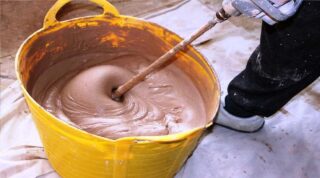
The ratio of clay and river sand for the masonry of the furnace depends entirely on the fat content of the first component. If the clay is medium-fat, for laying 100 bricks, a mixture will be required, including 2 buckets of clay, 2 buckets of sand and water so that the finished solution has a creamy consistency.
The specified composition is approximate. In fact, it is prepared by alternately adding one or another component until they get what they want.
To improve the characteristics of the composition, table salt and heat-resistant glue are added to it.
How to knead correctly
Clay fat level
The first thing to establish is the fat content of the material. Distinguish between lean, normal and oily clay. The first is non-plastic and dries up, the second shrinks slightly and does not crack. Dried plates of oily clay are elastic, but when dried they crack strongly, although they retain their strength.
To establish the fat content of the material, use the following methods.
- Soak the clay for a day, and then mold sausages from it 22 cm long and 1.5 cm in diameter.The harnesses are wound on a stick or branch with a section of 5 cm.The sausage made of fatty clay stretches and does not break, from normal it stretches, but cracks on the folds, tears out of dry.
- Dilute the material with water to the consistency of a pancake dough, mix with a spatula and remove the latter. If the layer on the shovel sticks to it, it is greasy clay, if it falls off in parts, it is normal, if it does not stick at all, it is skinny.
- Make a ball and press down with a board. If cracks appear when the ball is half flattened - the clay is oily, if 1/3 of the diameter is normal, if cracks appear even with light pressure - skinny, it will have to be enriched.
- The same ball is thrown to the ground from a height of 1 m. A product made of oily and normal clay does not break, it crumbles from a dry one.
Other methods take longer as the experimental samples need to be dried.
Selection and preparation of sand
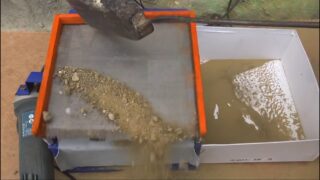
Both quarry sand and river sand are suitable for masonry mortar, but the latter is preferred. Here the grains of sand are rounded and more uniform in size. In addition, river sand is cleaner.
Career has to prepare:
- first, fragments of plants, leaves, pebbles are manually selected;
- sieved through an iron sieve with meshes of 1.5 mm;
- place the material in a bag or net and rinse under a pressure of water.
The composition of the sand does not really matter.
Preparation of clay-sand mortar
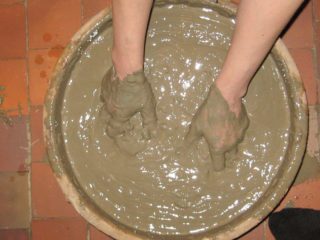
Making oven mortar is not easy. The following methods are known:
- The clay is poured with water for 24 hours and stirred until it becomes sour cream. Filter the resulting solution, attach sand to it and mix until smooth. If puddles appear, add a portion of sand and mix again.
- Clean clay is combined with sand in a ratio of 1: 2 and filled with ¼ volume of water. Mix and determine the quality by the state of the solution. The normal mixture is held on the shovel and slides slowly. With a lack of sand or high fat content of clay, the mixture is hardly shaken off the shovel.
If the slurry hardly holds and runs off, the clay has been too thin or a lot of sand has been added. In the latter case, you just need to add more clay.
If the material is skinny, you can add a portion of the purchased oily clay. Otherwise, you will have to carry out the laborious enrichment procedure.
It is necessary to dilute the clay for laying the stove according to the rules. It is poured into a trough, filled with water along the sides. On average, the ratio of clay mixture to water is 3: 1.
Quality checking
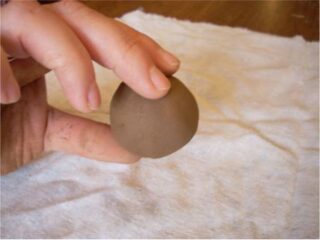
Before making a working portion, tests are carried out. They will need 5 containers.
Only clay is put in the first.In the second with the same volume of material, add half a portion of sand, in the third - a full portion, in the fourth - one and a half, in the fifth - 2 portions. Then add the same amount of water, stir and mold 10 balls from the resulting mixture - 2 for each mixture. A thin cake is made from 1 ball and left to dry for 12 days. Then they are examined.
When dropped from a height of 1 m, the ball does not break, the cake does not crack or crumble during drying - the mixture that gave such successful samples is the best option for clay mortar.
Clay is also recommended to be cleaned and rubbed through a sieve. The purer the material, the greater the heat capacity of the mixture.
Accessories for work
To prepare a solution with your own hands, you need the simplest tools: a trowel or a shovel for mixing, a construction mixer for making a large volume and capacity - a bucket, a trough.
Correcting cooking errors
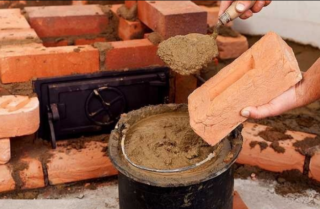
It is recommended to cook the entire required volume at once. The clay solution dries for a long time, the stove-maker has time. When the work is postponed for a day or two, the composition still dries up. To prevent this from happening, cover the bucket with the mixture with a wet cloth.
If the composition does dry up, it is broken with a hammer and filled with water for 24 hours. Then soften all the pieces of clay and mix again with a mixer.
If the solution is too thin, the excess liquid can be drained.
How long does it take to dry the oven
Clay masonry dries for a long time, so the stove is dried in 2 stages. Within 5–7 days, the structure dries up naturally - with the door of the firebox and ash pan open and with the dampers open. Then the stove is dried with a fan for another 9–12 days.
Then the stove is heated. Do this every day twice a day, but only a couple of logs.
Drying is considered complete at the moment when, after 3-4 hours after the furnace, no condensation appears on the walls.

